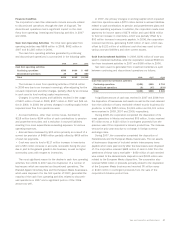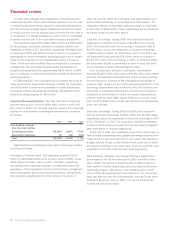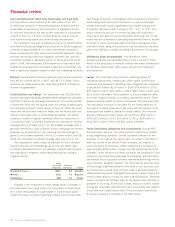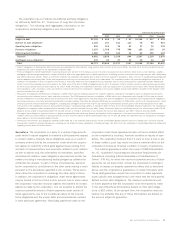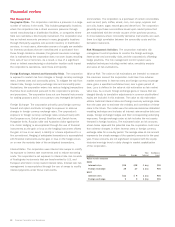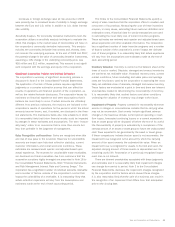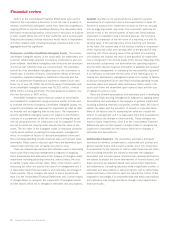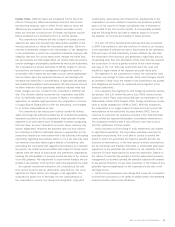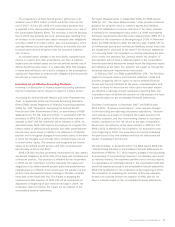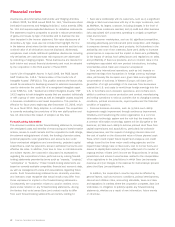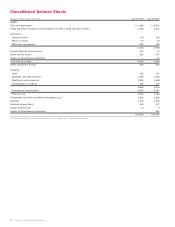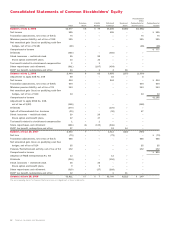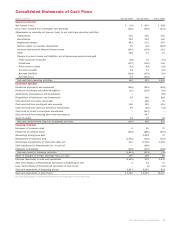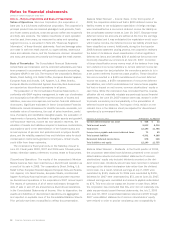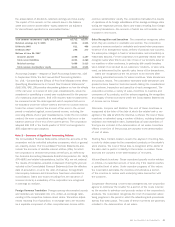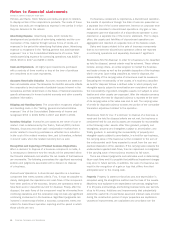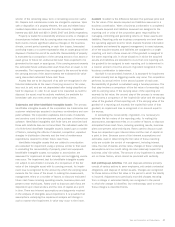Sara Lee 2008 Annual Report Download - page 39
Download and view the complete annual report
Please find page 39 of the 2008 Sara Lee annual report below. You can navigate through the pages in the report by either clicking on the pages listed below, or by using the keyword search tool below to find specific information within the annual report.The corporation’s defined benefit pension plans had a net
actuarial loss of $570 million in 2008 and $746 million at the
end of 2007. At June 28, 2008, the unamortized actuarial loss
is reported in the “Accumulated other comprehensive loss” line of
the Consolidated Balance Sheet. The reduction in the net actuarial
loss in 2008 was primarily due to an actuarial gain resulting from
an increase in the discount rate used to measure plan obligations
to 6.3% in 2008 from 5.4% in 2007. Also, the amortization of the
opening deferred loss was partially offset by an actuarial loss due
to actual asset returns being less than the assumed long-term
rate of return.
As indicated above, changes in the bond yields, expected future
returns on assets, and other assumptions can have a material
impact upon the funded status and the net periodic benefit cost of
defined benefit pension plans. It is reasonably likely that changes
in these external factors will result in changes to the assumptions
used by the corporation to measure plan obligations and net periodic
benefit cost in future periods.
Issued but not yet Effective Accounting Standards
Following is a discussion of recently issued accounting standards
that the corporation will be required to adopt in a future period.
Accounting for Defined Benefit Pension and Other Postretirement
Plans
In September 2006, the Financial Accounting Standards
Board (FASB) issued Statement of Financial Accounting Standard
(SFAS) No. 158, “Employers’ Accounting for Defined Benefit
Pension and Other Postretirement Plans, an amendment of FASB
Statements No. 87, 88, 106 and 132(R).” In accordance with the
provisions of SFAS 158, a portion of the requirements had been
adopted in 2007 and the remainder will be adopted in 2009, as
described below. SFAS 158 requires an employer to recognize the
funded status of defined benefit pension and other postretirement
benefit plans as an asset or liability in its statement of financial
position and to recognize changes in that funded status in the year
in which the changes occur through other comprehensive income
in shareholders’ equity. The company has recognized the funded
status of its defined benefit pension and other postretirement
benefit plans at the end of 2007.
SFAS 158 also requires consistent measurement of plan assets
and benefit obligations as of the date of the fiscal year end statement
of financial position. This provision is effective for the corporation
in 2009. As the corporation currently measures the assets and
obligations of its defined benefit pension plans and postretirement
medical plans as of March 31st of each year, the adoption of this
portion of the standard will require a change in the plan measure-
ment date to the fiscal year end. The impact of adopting the
measurement date provision of SFAS 158 will be recorded as an
adjustment to beginning of year retained earnings in 2009. The
corporation does not believe the impact will be material to the
consolidated financial statements.
Fair Value Measurements
In September 2006, the FASB issued
SFAS No. 157, “Fair Value Measurements,” which provides enhanced
guidance for using fair value to measure assets and liabilities.
SFAS 157 establishes a common definition of fair value, provides
a framework for measuring fair value under U.S. GAAP and expands
disclosure requirements about fair value measurements. SFAS 157 is
effective for the corporation at the beginning of 2009. In November
2007, the FASB decided to defer the effective date of SFAS 157 for
all nonfinancial assets and nonfinancial liabilities, except those that
are recognized or disclosed at fair value in the financial statements
on a recurring basis. The corporation is currently evaluating the provi-
sions of this new standard. We currently believe the adoption of
this standard will not have a material impact on the consolidated
financial statements because we already report the applicable assets
and liabilities at fair value. The adoption will impact us through the
enhanced disclosure requirements noted above.
In February 2007, the FASB issued SFAS No. 159, “The Fair Value
Option for Financial Assets and Financial Liabilities.” SFAS 159
provides companies with an option to report selected financial
assets and financial liabilities at fair value. Unrealized gains and
losses on items for which the fair value option has been elected
are reported in earnings at each subsequent reporting date. The
corporation does not believe the adoption of this standard will have
a material impact on the consolidated financial statements.
Business Combinations
In December 2007, the FASB issued
SFAS 141(R), “Business Combinations,” which requires changes
in the accounting and reporting of business acquisitions. The state-
ment requires an acquirer to recognize the assets acquired, the
liabilities assumed, and any noncontrolling interest in purchased
entities, measured at their fair values at the date of acquisition
based upon the definition of fair value outlined in SFAS No. 157.
SFAS 141(R) is effective for the corporation for acquisitions that
occur beginning in 2010. The corporation is currently evaluating
the provisions of this new standard and has not determined the
impact of adopting it at this time.
Minority Interests
In December 2007, the FASB issued SFAS 160,
“Noncontrolling Interests in Consolidated Financial Statements an
Amendment of ARB No. 51,” which requires changes in the accounting
and reporting of noncontrolling interests in a subsidiary, also known
as minority interest. The statement clarifies that a minority interest
in a subsidiary is an ownership interest in the consolidated entity that
should be reported as equity in the consolidated financial statements.
SFAS 160 is effective for the corporation at the beginning of 2010.
The corporation is evaluating the provision of this new standard;
however, we currently believe the adoption of SFAS 160 will not
have a material impact on the consolidated financial statements.
Sara Lee Corporation and Subsidiaries 37


